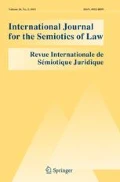Abstract
Law as one sign system can be recorded and interpreted by another sign system—media. If each transaction in court is taken as a sign, it can be interpreted or transferred by different signs of media for the same purpose, though with different effects. This study focuses on the transformative effects of the semiotic revolution in media on law. The present research revealed that the evolution of media has driven the administration of justice to pay more attention to the process of court proceedings. This research also discusses the semiotic conflict and compatibility between the sign subsystems within media upon interpreting the administration of justice. In addition, disequilibrium between different sign systems highlights the consequent need for intersemiotic translation, consciousness and evaluation as part of decision making on court domains.
Similar content being viewed by others
References
Baker, Mona, and Kirsten Malmkjær. 1998. Routledge encyclopedia of translation studies. London: Routledge.
Bignell, Jonathan. 1997. Media semiotics: An introduction. Manchester: Manchester University Press.
Chandler, Daniel. 2002. Semiotics: The basics. London: Routledge.
Cheng, Le, and King Kui Sin. 2008. Terminological equivalence in legal translation—A semiotic approach. Semiotica 172: 33–45.
Cohen, J.M. 2002. Inside appellate courts: The impact of court organization on judicial decision making in the United States courts of appeals. Ann Arbor: University of Michigan Press.
Danesi, Marcel. 2002. Understanding media semiotics. London: Arnold.
Daniel, W.T.S. 1884. The history and origin of “The Law Reports”. London: Wildy.
Jakobson, Roman. 1959. On linguistic aspects of translation. In On translation, ed. R.A. Brower, 232–239. Cambridge: Cambridge University Press.
McLuhan, Marshall. 1987. Understanding media: The extensions of man. London: Taylor & Francis. 1st ed. 1964.
Pache, Charlotte. 2007. The legal system, the courts and law reporting in Hong Kong. Legal Information Management 7: 90–92.
Peirce, Charles S. 1931–1958. Collected papers of Charles Sanders Peirce, vol. 8. In ed. Charles Hartshorne, Paul Weiss, and Arthur W. Burks. Cambridge: Harvard University Press.
Sager, Juan C. 1994. Language engineering and translation: Consequences of automation. Amsterdam: John Benjamins.
Scheffer, Thomas. 2006. The microformation of criminal defense: On the lawyer’s notes, speech production, and a field of presence. Research on Language and Social Interaction 39 (3): 229–261.
Sin, King Kui, and Derek Roebuck. 1996. Language engineering for legal transplantation: Conceptual problems in creating common law Chinese. Language & Communication 16 (3): 235–254.
Stygall, Gail. 1994. Trial language. Differential discourse processing and discursive formation. Amsterdam: John Benjamins.
Zander, Michael. 2004. The law-making process, 6th ed. Cambridge: Cambridge University Press.
Acknowledgments
I am grateful to two anonymous reviewers for helpful comments and suggestions. The work described in this paper was substantially supported by a grant from the Research Grants Council of the Hong Kong Special Administrative Region (Project No.: 1-ZV7D).
Author information
Authors and Affiliations
Corresponding author
Rights and permissions
About this article
Cite this article
Cheng, L. Administration of Justice and Multimodality in Media: Semiotic Translation, Conflict and Compatibility. Int J Semiot Law 24, 491–502 (2011). https://doi.org/10.1007/s11196-010-9175-8
Published:
Issue Date:
DOI: https://doi.org/10.1007/s11196-010-9175-8




